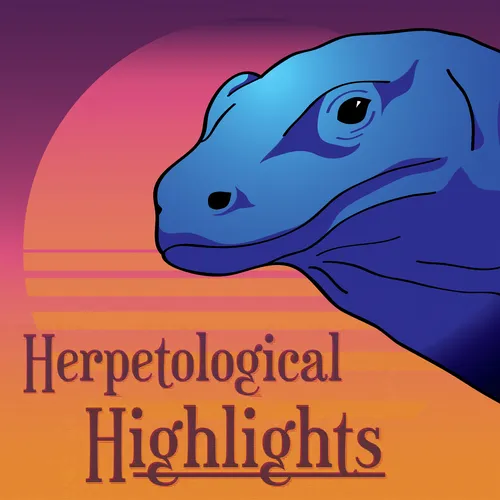
Herpetological Highlights
In Herpetological Highlights we will explore the recent scientific discoveries in the field of Herpetology. We'll cover everything from lizards to frogs, snakes, and toads. Every episode we'll be digging into the biology and ecology of these reptiles and amphibians in an attempt to disentangle the science. Hosted by Tom Major and Ben Marshall. Like us on facebook: www.facebook.com/herphighlights
- Update frequency
- every 7 days
- Average duration
- 49 minutes
- Episodes
- 238
- Years Active
- 2017 - 2025

155 No Eardrums, No Problem
It's a commonly held belief that snakes can't hear, or can't hear very well, because they have no external ear openings. Some clever new research puts that myth to bed.

154 The Frogs Who Live With Ants
Some animals can escape the attention of ants with special chemical cues. We discuss a nice example of this and follow up with a brand new frog species.

153 The Rising Toad Tide
Toads are wonderful creatures, and their exceptional adaptability makes them superb invaders when transported to new lands by humans. Unfortunately, this can be bad news for the creatures already pre…

152 Pythons as Prey
We have previously talked about pythons in Florida eating everything they can fit in their mouths; but are there any creatures that eat them? We follow up the chat of python predators with a new tiny…

151 Glassfrogs and Their Transparent Tricks
Some frogs can make themselves virtually invisible to would-be predators - we find out how.

150 The Underwater Antics of Turtles
New techniques allow unprecedented insight into the underwater behaviour of Australia's flatback sea turtles. Then we chat about some newly described spiny lizards from Peru.

149 The Hidden Risk of Carrying Tadpoles
Brightly coloured frogs warn predators of their toxicity, but can tadpoles stop this message from being delivered?

148 Snakes with Dangerous Diets
Eating without appendages is hard, and sometimes snakes make a meal of it.
Become a Patreon: https://www.patreon.com/herphighlights

147 Crocodiles can feel with their face
Some animals use touch to forage; turns out crocodiles are among them. But when did this adaptation come about and do crocs share characteristics with other tactile-foraging species?

146 Iguanas with a Sweet Tooth
What are the impacts of tourists feeding iguanas grapes? We look at a paper detailing how well iguanas can handle so many sweet treats. Species of the Bi-week is a wonderful boa that isn’t a boa.

145 Vipers On Ice
Despite a warming planet, new research suggests that snakes in the UK may have more frosty mornings ahead. Then Sourish Kuttalam from Bangor University joins us to talk about a newly described viper …

144 New Zealand’s Native Frogs
We uncover some small and unusual frogs native to the islands of New Zealand.
Become a Patreon: https://www.patreon.com/herphighlights
Full reference list available here: http://www.herphighlights.po…

143 Can frogs stand the heat?
The climate crisis presents numerous questions about how animals will cope. We look at one frog-focused example where the researchers actually heated up a forest.

142 Alligators can regrow their tails
Tail regrowth is a weird and wonderful trait some herpetofauna possess. But there’s a new paper about the regrowing tails of alligators. Species of the Bi-week is more like Genus of the Bi-week.

141 Mountain Dragons
Mountain dragons are found in Australia and Tasmania. We get stuck in to the ecology of these busy little lizards.

140 Snake Diets Through the Ages
After the dinosaurs went extinct snakes were feeling hungry.
Become a Patreon: https://www.patreon.com/herphighlights
Full reference list available here: http://www.herphighlights.podbean.com
Main …

139 Can brownsnakes be bothered?
Elapid behaviour is not as well studied as we’d like, so in this episode we look at a couple of papers to cover more ground. One describing the changing morphology to optimise caudal luring, and anot…

138 Evolving Anoles
The complexities of evolution pose constant questions. One of the most fruitful groups to look at when trying to understand evolution is Anolis lizards. They are well known for repeated convergent ev…

137 Switzerland’s Frog-enaissance
Back in the 90s the Swiss authorities decided to start digging loads of ponds for their dwindling amphibians. But did these uniquely slippery customers appreciate it?

136 Set a course for Tiny Boa Island
Central American boas are the focus of this episode - we disentangle why some are large, and others are very small. Followed up by a Species of the Bi-Week with a stubby tail.